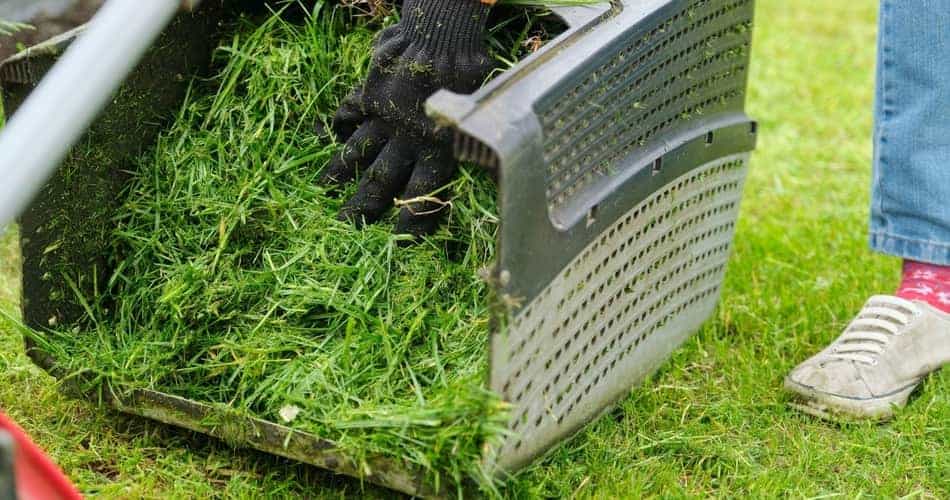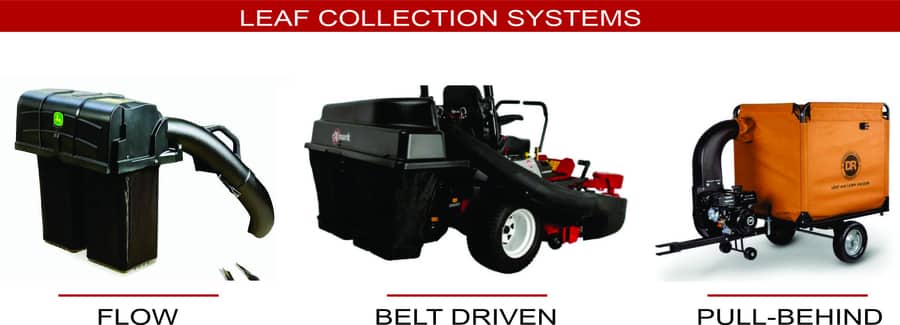15 Reasons Why Your Lawn Mower Is Not Picking Up Grass
Working in the lawn and garden industry, I get many questions about why grass collection systems are not picking up grass. This is a common problem that, most of the time, can be prevented or fixed with light repairs and a little routine preventative maintenance.
Your lawn mower leaf collection system may not be picking up grass because air is being restricted due to clogs in the blower system often a result of dull blades, debris buildup, and blocked inlet screen. A belt-driven collection system could have a bad belt, damaged impeller, or bad bearings.
Before I go more in-depth with the reason that your grass catcher may be clogged, you need to identify the type of grass collection system you have.

This post may include affiliate links. Purchases made through these links may provide a commission for us, at no extra cost to you. As an Amazon Associate, we earn from qualifying purchases.
Follow all safety instructions provided in your equipment operator’s manual prior to diagnosing, repairing, or operating.Consult a professional if you don’t have the skills, or knowledge or are not in the condition to perform the repair safely.
Table of Contents
3 Types of Riding Lawn Mower & Zero Turn Grass Collection Systems
There are three types of grass collection systems available: flow, belt powered, and pull behind.

Flow Grass Collection Bagger System
Flow bagger systems are the least complicated grass collection systems used on riding and zero-turn lawn mowers. Airflow created by the blades moves the cut grass through a tube and into the attached grass catcher bag.
On a push mower, the grass is pushed through the discharge chute and directly into the attached grass catcher bag.
Belt Driven Grass Collection Bagger System
The belt-driven grass collection system uses an additional belt to drive the impeller fan which creates a greater air velocity. This increased air movement pushes grass into the bags. The fan is encased by the blower housing.
This housing is attached to the side discharge on the mower deck. A tube then comes off of the blower housing to carry grass to the bags.
Pull-Behind Grass Collection Bagger System
The pull-behind bagger system draws grass into a trailer type pull-behind grass collector through a tube off of the mower deck. A separate engine is used to run a vacuum system to pull grass clippings into the grass collection bags.
15 Reasons Your Lawn Mower Isn’t Picking Up Grass
Your lawn mower bagger may continue to get clogged when there is a lack of air movement due to grass buildup under the mower deck, worn blades, and plugged inlet screen.
Bad belts, impeller, and housing can also cause the grass to become built up in the blower tubes and chute with a belt-style grass collection system.
Clogged Tubes
Remove the blower tubes and look down at them to see if they are plugged. You are looking for old grass, sticks, or other debris that might be clogging the tube. You can scrape and clean out the grass and remove additional debris.
Before you place the clean tubes back onto your mower, do yourself a favor and spray the inside of the tube with silicone spray. This will prevent grass from sticking inside the tube for a while.
It’s a good idea to do this every other time you mow and grass will rarely have time to build up in the tubes. We like Tite-Seal Mower Deck Spray.
Clogged Mower Deck
Safely raised the mower into the air so you can look underneath the deck. To be safe, use jacks or jack stands to keep the mower in the air. Look at the mower deck. Is it packed full of grass? If it is, you need to remove the grass and scape the deck to keep it clean.
A mower deck that is full of grass will not get the airflow needed to pick up grass and give us a nice cut. It may not allow you to get enough air to push the grass through the tubes.
Worn or Damaged Mower Blades
Inspect the mower blades to see if the sails are worn off the top of the blades. If the sails (which is the high side of the blade) are worn you will not be able to move the grass around the underside of the deck. You will not be able to get grass into the tubes.
Make sure your blades are sharp and in good condition to give you a good cut to push clippings into the bagger.

Wrong or Incorrectly Installed Mower Blades
There are many different types of mower blades on the market today. When using a bagger system, you need to create lift and air movement for the best bagger performance.
Because of this, it is best to use a high-lift blade. This blade has a taller sail (of fin) on the blades to create the lift needed.
When inspecting your blades on the deck, make sure the sail is up when installed. The sail should be pointed toward the deck. This creates a vacuum under the deck.
Read our article, “This is the Way the Blade Goes On A Lawn Mower” to find out more about lawn mower blade types and installation.
Clogged Grass Chute
Take a look at the grass chute as this area can become plugged with old or wet grass. Clean this area to allow air to move grass up the tubes. You can also use a silicone spray inside the chute to help grass flow better.
Clogged Inlet Tube
Remove the bags or catchers, whichever your unit has, off the grass hopper. Look at the inlet tube to make sure you are not plugged up there. Clean it out if necessary.
Plugged Inlet Screen
The inlet screen is one thing most people forget to check. The screen lets air out of the hopper so it can carry grass up the tubes. If this screen is plugged you can lose the air draft that carries the air clippings. When clogged, the system will not load the bags with grass.
The screen is usually at the top of the hopper where no one can see it. Because you can’t see the screen one normally forgets it exists and it becomes full of grass clippings.
When you pick the hopper cover up you are not seeing the screen because it is located on the side of the cover not exposed to you.
The screen can easily be cleaned with your hand. A wire brush can be used for tough build-ups. Once you have it clean, spray it with silicone spray and let it dry.
Bad Deck Belt
With a belt-driven grass collection system, the belt on the deck needs to be inspected because this is the belt that drives the blower belt for the fan. Remove the belt covers and check the drive belt from blade to blade.
If this belt has cracks in it or is glazed or shiny you need to replace it. If the belt sits deep inside the pulleys, you should consider replacing it.
Bad Blower Belt
Look at the belt on the fan on a belt-driven grass collection system. Replace the belt if you notice it is shiny in appearance and has multiple cracks in it.
Worn Fan or Housing
The fan encased in the blower housing is often called the impeller on the belt-driven grass collection system. Check the condition of the fan blades and blower housing.
If the fan blades or housing are worn you will lose some of the airflows to get grass clippings into the hopper. This is a very important part of the collection system.
When the gap between the fan and the housing is far apart you will lose airflow.
Bad Bearings in Blower Housing
If your bagger has a blower housing, there is a set of bearings on the fan shaft that could be bad. String or even grass wrapped around the fan shaft can cause the bearings to go bad.
On most units, you will require the disassembly of the blower housing to check the fan out.
Not Enough Engine Speed
Another thing you need to keep in mind while mowing with a bagger is engine speed. We need the engine to run at maximum horsepower to run the bagger.
When running your bagger and it sounds like the engine is not quite giving all it has then you need to look at the engine. Most engines should run about 3200 to 3650 rpm to give you all the power you need out of the engine.
Wet Grass
You should never cut wet grass and expect to have a good bagging experience. Wet grass is heavier and tends to build up and stick to the underside of the mower deck and inside the blower chute. This build-up restricts airflow for your bagger system.
It’s best to wait to mow and bag once your grass is dry. Not only will your bagging for the day go better, but the maintenance you’ll have to complete later to clean out your bagging system is also a lot less work.
Wrong or Damaged Bags
Bags used on bagger systems used to be made of cloth and sometimes they can be repaired if they get a hole in them. Today, most bags are made of a mesh or loosely knitted polyester or nylon type material and are not easily repaired.
The life of a bag can be two to three years depending on how much dirt or debris you pick up and if anything gets caught in the bag.
The newly designed bags are designed to allow air movement through the mesh vents. Without bags that allow air to move through the bags, the bags will continually expand with the buildup of grass and air and cause damage to the bags.
Bagger Not Secured or Attached Properly
When your bagger isn’t assembled or secured properly, you can have areas where air escapes through the system and causes reduced air movement. Grass build-up can also be a result of not being assembled and attached correctly.
Still Having Problems with Your Lawn Mower?
Lawn mower ownership doesn’t come without its frustrations. Own a lawn mower long enough, you are bound to run into many lawn mower problems including starting, smoking, leaking, cutting, and overheating.
For a list of the most common lawn mower problems and items that can cause them, check out my guide “Common Lawn Mower Problems: Solved!“







